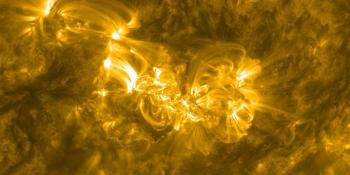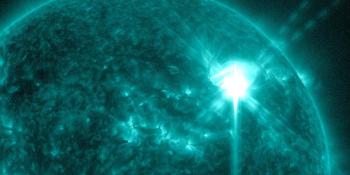Visualizzazione archivio di domenica, 8 febbraio AM
Rapporto attività solare
Ogni brillamento solare menzionato nel rapporto ha un fattore di scala, applicato dal Centro di Predizione Meteorologica Spaziale (SWPC). A causa del fattore di scala del SWPC, i brillamenti solari sono segnalati come ridotti del 42%, rispetto ai dati di qualità scientifica. Il fattore di scala è stato rimosso dai nostri dati archiviati sui brillamenti solari, per riflettere le unità fisiche reali.
Rapporto dell'Attività Geofisica Solare 2004 Feb 08 2200 UTCPreparati dal SWPC della NOAA© ed elaborati da SpaceWeatherLive.com
Rapporto Congiunto USAF/NOAA dell'Attività Solare e Geofisica
SDF Numero 039 Emesso alle 2200Z il Feb 08 2004IA. Analisi delle Regioni Solari Attive e Attività dalle 2100Z-07 alle 2100Z-08 Solar activity increased to moderate levels in the last
minutes of the period. Region 554 (S08E62) produced an M1/Sf event
at 08/2051Z. Multiple B and C-class flares where attributed to this
region during the period. This region has recently rotated onto the
visible solar disk and may have a weak gamma magnetic structure in
the trailing portion of the sunspot cluster, currently analyzed as a
beta group. Region 551 (S06W14) continues to show steady growth in
penumbral coverage and continued counter-clockwise rotation of the
intermediate sunspots was evidenced once again during the interval.
A single lesser B-class flare was the extent of flare activity in
this region today. Spotless active Region 553 (S04W38) managed to
produce a C1 x-ray flare at 08/0452Z. No new regions were numbered
today.
IB. Previsione dell'Attività Solare
Solar activity is expected to be at
low to moderate levels. Regions 551 and 554 have the potential to
produce isolated M-class flare activity.
IIA. Sommario dell'Attività Geofisica dalle 2100Z-07 alle 2100Z-08
The geomagnetic field was at quiet to unsettled levels. The greater
than 2 MeV electron fluxes at geosynchronous orbit reached high
levels today.
IIB. Previsione dell'Attività Geofisica
The geomagnetic field is
expected to be at quiet to unsettled levels. Isolated active
conditions may be possible in the nighttime sectors throughout the
period.
III. Probabilità dell'Evento dalle Feb del 09 alle Feb del 11
| Classe M | 50% | 50% | 50% |
| Classe X | 10% | 10% | 10% |
| Protone | 01% | 01% | 01% |
| PCAF | green | ||
IV. Flusso di 10.7 cm di Penticton
Osservato 08 Feb 116 Previsto 09 Feb-11 Feb 120/120/115 Media di 90 Giorni 08 Feb 121
V. Indici Geomagnetici A
Osservato Afr/Ap 07 Feb 005/011 Stimato Afr/Ap 08 Feb 005/008 Previsto Afr/Ap 09 Feb-11 Feb 008/010-008/010-008/010
VI. Probabilità dell'Attività Geomagnetica dal 09 Feb al 11 Feb
| A. Latitudini Medie | |||
|---|---|---|---|
| Attivo | 20% | 20% | 20% |
| Tempesta minore | 05% | 05% | 05% |
| Tempesta maggiore-grave | 01% | 01% | 01% |
| B. Latitudini Alte | |||
|---|---|---|---|
| Attivo | 20% | 20% | 20% |
| Tempesta minore | 10% | 10% | 10% |
| Tempesta maggiore-grave | 05% | 05% | 05% |
<< Vai alla pagina della panoramica giornaliera
Ultime notizie
Ultimi messaggi dal forum
AR3664 398[CME] AR 13664, X1.04, 2024-05-08 76Sporadic E and Flare activity 23all these X- and M- flares CME 08.05-09.05 2Unproven theories 387
Altri argomentiSupporta SpaceWeatherLive.com!
Molte persone vengono su SpaceWeatherLive per seguire l'attività del Sole o sapere se ci sia la possibilità di vedere l'aurora, ma a maggior traffico corrispondono costi maggiori. Considerate una donazione se vi piace SpaceWeatherLive così che possiamo mantenere online il sito web!

Notizie sul meteo spaziale
| Ultimo brillamento X | 2024/05/09 | X2.2 |
| Ultimo brillamento M | 2024/05/09 | M2.0 |
| Ultima tempesta geomagnetica | 2024/05/06 | Kp5 (G1) |
| Giorni senza macchie | |
|---|---|
| Ultimo giorno senza macchie | 2022/06/08 |
| Media mensile Numero di Macchie Solari | |
|---|---|
| aprile 2024 | 136.5 +31.6 |
| Last 30 days | 163.9 +73.1 |


